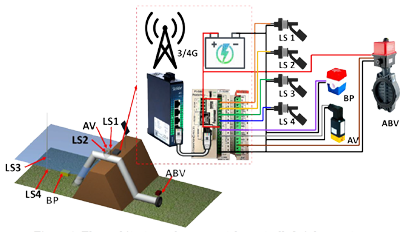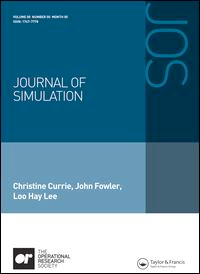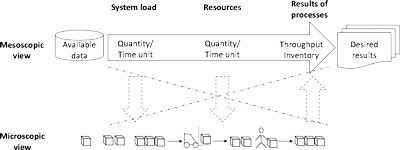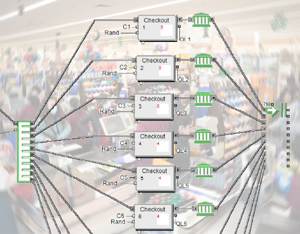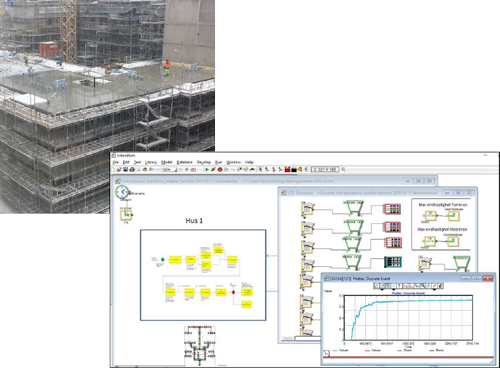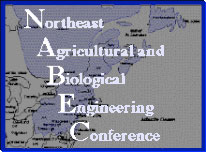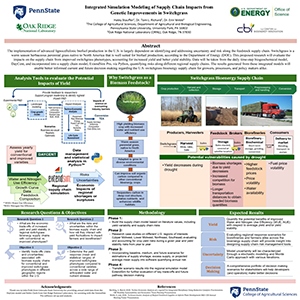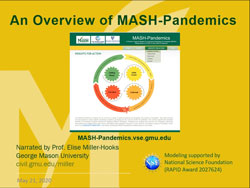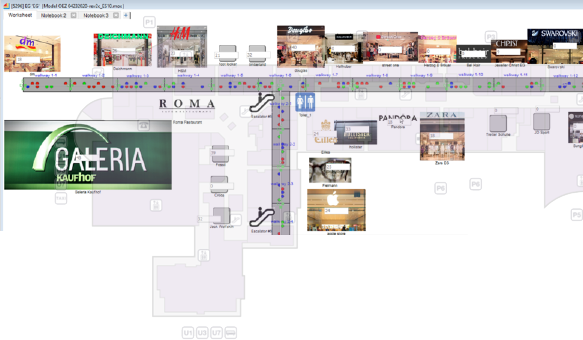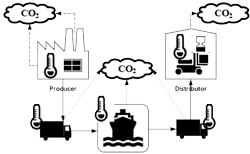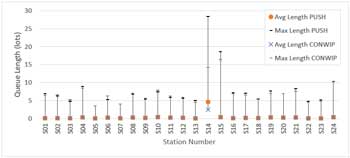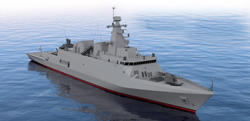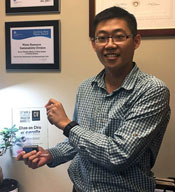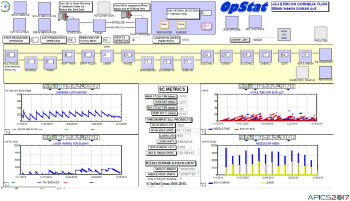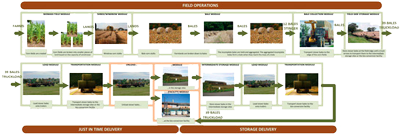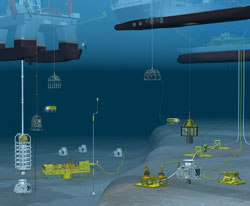New and innovative solutions powered by ExtendSim.
Adham Hendawy, Marwan Nagy, Farida Haytham, Justin Sameh, & Mayar Essam of the Arab Academy for Science, Technology and Maritime Transport
July 2025
A factory producing over 400 powdered mix products commissioned a team of engineering students to enhance production efficiency by addressing bottlenecks and changeovers in their line, particularly with the integration of a new machine. Using ExtendSim to model the production line, the research evaluated various product sequencing strategies and scheduling practices. Testing 206 scenarios revealed that optimizing the scheduling order significantly reduced cycle times, minimized downtime, and improved workflow integration. The successful results demonstrated that adjusting the scheduling order can enhance system performance, increase throughput, and better meet customer demand. The study concluded that optimizing production scheduling and implementing lean methods like Kanban or CONWIP can significantly improve overall efficiency and reduce delays.
Regional Maximum Hospital Capacity Estimation for COVID-19 Pandemic Patient Care in Surge Through Simulation
Bahar Shahverdi, Hadi Ghayoomi. & Elise Miller-Hooks, Department of Civil, Environmental & Infrastructure Engineering, George Mason University; Mersedeh Tariverdi, The World Bank Group; Thomas D. Kirsch, National Center for Disaster Medicine and Public Health
Proceedings of the 2022 Winter Simulation Conference
December 2022
Estimating the capacity of a region to serve pandemic patients in need of hospital services is crucial to regional preparedness for pandemic surge conditions. This paper explores the use of techniques of stochastic discrete event simulation for estimating the maximum number of pandemic patients with intensive care and/or in-patient, isolation requirements that can be served by a consortium of hospitals in a region before requesting external resources. Estimates from the model provide an upper bound on the number of patients that can be treated if all hospital resources are re-allocated for pandemic care. The modeling approach is demonstrated on a system of five hospitals each replicating basic elements (e.g. number of beds) of the five hospitals in the Johns Hopkins Hospital System in the Baltimore-Washington, D.C. Metropolitan area under settings relevant to the COVID-19 pandemic.
Alexander Hedlund & Olof Björkqvist, Faculty of Science, Technology and Media, Campus Sundsvall, Mid Sweden University
Anders Nilsson & Per Engstrand, FrontWay AB, Norrkoping, Sweden
Energies 2022 • Feature Papers in Energy, Environment and Well-Being
April 2022
Although there are opportunities to reduce electrical energy demand in unit processes of mechanical pulp-based paper and paperboard production, this may not be financially beneficial. This is generally because energy optimization opportunities connected to reduced refiner electricity demand in mechanical pulping systems also results in less steam available for the drying of the paper. As modern high consistency refiner systems produce approximately one ton of steam for each MWh of electricity when producing one ton of pulp, a reduction in electric energy demand leads to increased fuel demand in steam boilers to compensate for the steam shortage. In this study, the authors investigated what the financial and environmental situation would look like if they were to expand the system border from a paper mill to a larger system consisting of a mechanical pulp-based paper or paperboard mill, a district heating system with an incineration boiler and a chemical pulp mill. For this purpose, the authors used the FrontWay module with ExtendSim which dynamically allows them to evaluate different scenarios. Their results shows that there is great potential to reduce both carbon dioxide emissions and production costs for industry sites and society by means of these tools.
Thomas Edmunds, COVID Systems Analysis Group
Lawrence Livermore National Laboratory
December 2021
The SARS-CoV-2 pandemic has driven a need for models that can predict transmission among populations and test the effectiveness of proposed interventions to control it such as testing, quarantining, vaccinations, and nonpharmaceutical interventions. This report describes a hybrid approach that is mostly agent based, but utilizes Ro and time frames from ordinary differential equation (ODE) models to estimate infection rates and reduce data requirements. The ExtendSim model developed is intended to inform management decisions regarding testing and quarantine policies and technologies.
Cost Analysis for Operational and System Level Considerations for an Electromagnetic Railgun on an Amphibious Platform
Christian Diaz, Paul T. Beery, and Anthony G. Pollman
Department of Systems Engineering • Naval Postgraduate School
Presented at the 2021 Winter Simulation Conference
December 2021
This article investigates outfitting an amphibious platform with an electromagnetic railgun (EMRG), which is a high velocity weapon that can fire projectiles at ranges up to 100 nautical miles. An EMRG would provide the amphibious fleet with offensive capability, as well as defensive capability against surface threats, missiles, and airborne threats. Because the railgun remains in the early stages of development, the Navy’s railgun prototype has been modeled in ExtendSim. Detailed assessment of changes to EMRG design suggest that improvements to the probability of hit of the EMRG has a greater impact on performance than improvements to either cycle time or engagement range. This provides an opportunity for tradeoffs to be made in the design of the railgun and its projectile in which the power requirements (and size) can be scaled down without negatively impacting effectiveness, provided the probability of hit of the projectiles is not reduced.
Robert Brownie, Evrim Kilic, & Dr. Peter O'Neill of Insight Acumen
Presented at the Australasian Simulation Congress 2021
November 2021
This video details the construction and implementation of a model that meets the challenge of designing a new hospital. Rob Brownie discusses how Insight Acumen used simulation to move from a planned pilot system to an effective, efficient operation that is able to forecast future demand with reasonable confidence.
Ali Mohamed Fathy, Mostafa Ayman Nabhan, Huda Ahmed Afifi, & Pola Adel Mahrous
Arab Academy for Science, Technology and Maritime Transport
Department of Civil and Environmental Engineering
September 2021
Integrating sustainability aspects with operational production scheduling proved to yield significant results for a chewing gum company. Minimizing energy costs just by scheduling the operations on a production is significant on an environmental level, even more than on economical levels. Finding a suitable changeover schedule can make huge differences on the production level, whether minimizing energy costs, minimizing the number of stops and increasing the production line productivity. Going with the simulation approach lead to the testing of many scenarios in a very short time period, giving more time for result analysis and finding ways to reduce the energy consumption even more, whether by finding a more suitable changeover schedules, or discovering bottlenecks that would not have been discovered by other solution techniques. The speed-scaling strategy proved to have a far more important role than just reducing the energy consumptions on machines by slowing them. Utilizations of production lines can be increased if the position of bottlenecks can be identified and the machine speeds are increased slightly.
Operational Reliability Assessment of a Remotely Controlled Siphon System for Draining Shallow Storage Ponds
Linlong Bian, Vivek Verma, Aditia Rojiali, Dogukan Ozecik, & Arturo S. Leon
Department of Civil and Environmental Engineering, Florida International University
Presented at the World Environmental and Water Resources Congress
July 2021
To determine the operational reliability of a remotely controlled siphon system in multi-wetland systems, an ExtendSim model was built to simulate the siphon flow rate and the time to empty to the wetlands. The siphon system mostly consists of water level switches, air vents, bilge pumps, and an actuated butterfly valve. In this study, the ExtendSim reliability block diagram (RBD) module is employed to assess a remotely controlled siphon system’s operational reliability. The Monte Carlo simulation results from the RBD model demonstrates that the non-repairable siphon system’s operational availability can be enhanced from 0.683 to 0.855 within a 1-year life cycle by increasing the safety factor to 2 for the vulnerable components, such as the water level switch and the air vent. The value can increase to 0.999 when adopting an on-site maintenance strategy. Based on the analysis of multiple scenarios and maintenance strategies, a suitable architecture of the siphon system will guide the field construction work for 12 wetlands in Texas.
Modelling Mass Crowd Using Discrete Event Simulation: A Case Study of Integrated Tawaf and Sayee Rituals during Hajj
Almoaid Owaidah, Doina Olaru, Mohammed Bennamoun, & R. Nazim Khan • Department of Computer Science and Software Engineering, Business School, and the Department of Mathematics and Statistics at the University of Western Australia
Ferdous Sohel • Discipline of Information Technology, Murdoch University
IEEE Xplore • Volume 9
May 2021
Hajj is a mass gathering event that takes place annually in Makkah, Saudi Arabia. Typically, around three million people participate in the event and perform rituals that involve movement within strict space and time restrictions. Despite efforts by the Hajj organizers, such massive crowd gatherings and movement causes overcrowding problems at the Hajj sites.There are are two important rituals that are performed by all the pilgrims at the same venue on the same day - Tawaf, followed by Sayee. Several previous simulation studies on Hajj have focused on the rituals individually. This paper studies both events jointly, rather than separately. Using ExtendSim, the authors integrate the Tawaf and Sayee rituals into one model. The validated model was applied to a wide range of scenarios where different percentages of pilgrims were allocated to the various Tawaf and Sayee areas. The effect of such allocations on the time to complete Tawaf and Sayee indicate strategies for managing these two key Hajj rituals.
Tobias Reggelin, Sebastian Lang, and Christian Schauf
Published in the Journal of Simulation
November 12, 2020
The application of mesoscopic discrete rate simulation models for two typical planning tasks in the automotive industry are demonstrated by the authors to illustrate the capability of this modelling class to meet the requirements of logistics and production planners by providing more accurate simulation results. Typically, planning engineers solve these tasks with detailed microscopic simulation models because of the availability of object-based discrete event simulation tools in the automotive industry, which leads to complicated and slow models. However, the combined use of discrete rate and discrete event modeling in mescoscopic models can represent logistics flow processes on an aggregated level through piecewise-constant flow rates by applying the discrete rate simulation paradigm instead of modelling individual flow objects leading to fast model building and computation.
Jacek Zabawa, Wroclaw University of Science and Technology
Presented at the 35th IBIMA Conference, Seville, Spain
April 2020
How might one both prevent and control an epidemic spreading of disease (for example COVID-19) in supermarkets? To answer this question, a simulation approach was proposed. A number of simulation experiments were performed. The likelihood of close contact with a carrier in different ticket queue configurations was compared. Based on the results, several tips and advice was developed for customers and market managers.
An Integrated Simulation-Based Method for Considering Weather Effects on Concrete Work Tasks’ Productivity and Concrete Curing
Robert Larsson, Lund University
Research project in conjunction with the Swedish construction industry's organization for research and development (SBUF) and Cementa AB
September 2020
This report presents an integrated simulation-based approach to study the on-site production of concrete frameworks by considering the multiple effects of weather on work task productivity and concrete curing process. The ExtendSim model created reports simulated construction time, cost, and CO2 emissions for a specific construction setup to facilitate planning and decisions related to resource allocation strategies, construction schedules, different concrete types (including climate-improved concrete), and curing measures for different types of expected weather conditions.
Haley Stauffer, Pennsylvania State University
Using ExtendSim Research Grant for her Masters of Science in Agricultural and Biological Engineering
Poster presentation at the Northeast Agricultural and Biological Engineering Conference
July 2020
Using an ExtendSim Research Grant for her Masters thesis, Ms. Stauffer is providing an academic addition to the existing literature to better improve further knowledge of switchgrass supply chain needs and management. Working in conjunction with Oak Ridge National Laboratory (ORNL), The Center for Bioenergy Innovation, and the US Department of Energy's Office of Science, Ms. Stauffer submitted and was awarded first place in the poster competition at the Northeast Agricultural and Biological Engineering Conference (NABEC). Once her project is completed, ORNL will be utilizing this data to further their efforts in industrial scale research of bioenergy production from switchgrass.
A Portal to Support Models for Assessing Strategies for Hospitals • Responding to COVID-19 and Other Pandemics
A Portal to Support Models for Assessing Strategies for Hospitals • Responding to COVID-19 and Other Pandemics
Collaboration between George Mason University, The World Bank Group, & Johns Hopkins University
May 2020
A portal is designed to support hospitals and regional administrators in responding to the current COVID-19 pandemic and other disease outbreaks. Using mathematical modeling, this collaboration of experts provides recommendations to help hospitals adapt and coordinate to meet demand surges. MASH-Pandemics can:
- Recommend how to increase capacity by providing alternative standards of care, changing operations,or managing demand
- Assess how hospitals can work together to build strong regional responses
- Estimate and prioritize critical supply needs to mobilize supply chains and other external supports
- Measure the evolving response capacity and capability of hospitals
Shujing Deng, Technischen Universität München
April 3, 2020
To truly estimate the life cycle of a building, it’s important to find a way to quantify the usage intensity of its individual components. Generally, many factors have an impact on the life span of the components in a building, such as product quality, maintenance, and visitor interaction with the building components, but how can you do that in a building type where user structure and interaction are too complex to analyze, such as in a shopping mall? Using ExtendSim, Shujing Deng created an agent-based model of a real shopping mall with over 100 shops on two floors. Adding the logic of a decision-making mechanism to enable the monitoring of all the interactions between customers and the main building components in the mall, the dynamics of user-space relationships within the shopping mall can be observed, exposing the usage intensity regarding building components. Running different scenarios, simulation results indicate the usage of building components mainly depends on the total number of the consumers in the mall interacting with the objects.
Bahar Shahverdi, Mersedeh Tariverdi, Elise Miller-Hooks
George Mason University • Department of Civil, Environmental, and Infrastructure Engineering • PhD in Transportation
Published 25 July 2019 in Socio-Economic Planning Sciences
How effective are formalized collaboration strategies when responding to a disaster incident involving mass casualties and area-wide damage? How best can patients be transferred and resources, including staff, equipment and supplies, be shared across hospitals? ExtendSim was used to help quantify hospital system resilience to pandemic, MCI, and disaster events with damage. Patient flows through 9 critical units of multiple hospitals spaced over a large metropolitan region were analyzed to determine impacts on critical resources, physical spaces, and demand. Hospital resilience to these hazard events was evaluated to show the potential of strategies involving not only transfers and resource sharing, but also joint capacity enhancement alternatives to improve post-disaster emergency health care service delivery through joint action.
Hagar Amer, Noha Galal, Khaled El-Kilany • Dept of Industrial and Management Engineering • Arab Academy for Science, Technology, and Maritime Transport
Presented at the International Conference on Industrial Engineering and Operations Management • Paris, France
July 2018
Due to the globally increasing concern of public health regarding food safety, and quality, the management of agri-food supply chains (ASC) has become even more complex given its special characteristics of perishability, uncertainty of supply and demand, and managing the carbon dioxide equivalent emissions produced throughout the supply chain due to cooling, transportation, and disposal of fresh produce. Using ExtendSim, researchers modeled a two-echelon real life supply chain to study the effect of changing order quantity under uncertain demand and lead time on a set of economic, social, and environmental performance measures. Model results help to minimize food wastage, offer higher quality fresh produce, and lower emissions while maintaining the highest profit and an acceptable service level.
Yassin Shaalan, Ingy El-Khouly, and Khaled El-Kilan • Dept of Industrial and Management Engineering • Arab Academy for Science, Technology, and Maritime Transport
Presented at the International Conference on Industrial Engineering and Operations Management
March 2018
Reentrant flow lines are a special type of production flow line in which a job may visit a machine or group of machines more than once. This reentrancy characteristic results in higher variability of cycle time and throughput rates when compared to traditional production flow lines. A simulation study using ExtendSim shows that by dividing a production line into segments using different CONWIP levels affects the line performance. In fact, in some instances, compared to a single segment CONWIP and push system, using segmented CONWIP can achieve the same throughput rate in a shorter cycle time.
Bhavna Sharma1, Robin Clark, Michael R. Hilliard, and Erin G. Webb
Frontiers in Energy Research • Bioenergy & Biofuels
25 September 2018
Lignocellulosic biomass derived fuels and chemicals are a promising and sustainable supplement for petroleum-based products. Currently, the lignocellulosic biofuel industry relies on a conventional system where feedstock is harvested, baled, stored locally, and then delivered in a low-density format to the biorefinery. However, the conventional supply chain system causes operational disruptions at the biorefinery mainly due to seasonal availability, handling problems, and quality variability in biomass feedstock. Operational disruptions decrease facility uptime, production efficiencies, and increase maintenance costs. For a low-value high-volume product where margins are very tight, system disruptions are especially problematic. In this work we evaluate an advanced system strategy in which a network of biomass processing centers (depots) are utilized for storing and preprocessing biomass into stable, dense, and uniform material to reduce feedstock supply disruptions, and facility downtime in order to boost economic returns to the bioenergy industry. A database centric discrete event supply chain simulation model was developed, and the impact of operational disruptions on supply chain cost, inventory and production levels, farm metrics and facility metrics were evaluated. Three scenarios were evaluated for a 7-year time-period:
- bale-delivery scenario with biorefinery uptime varying from 20 to 85%
- pellet-delivery scenario with depot uptime varying from 20 to 85% and biorefinery uptime at 85%
- pellet-delivery scenario with depot and biorefinery uptime at 85%
In scenarios 1 and 2, tonnage discarded at the field edge could be reduced by increasing uptime at facility, contracting fewer farms at the beginning and subsequently increasing contracts as facility uptime increases, or determining alternative corn stover markets. Harvest cost was the biggest contributor to the average delivered costs and inventory levels were dependent on facility uptimes. We found a cascading effect of failure propagating through the system from depot to biorefinery. Therefore, mitigating risk at a facility level is not enough and conducting a system-level reliability simulation incorporating failure dependencies among subsystems is critical.
Ghada Yehia Mostafa, N.M. Galal, K.S. El-Kilany
Masters in Industrial Engineering • Arab Academy for Science, Technology, and Maritime Transport
IEEM 2018 -- International Conference on Industrial Engineering and Engineering Management
Establishing a pricing strategy and managing inventory of perishable products can easily be a retailer’s nightmare. How do you maximize revenue while minimizing food waste? As a product nears the end of its lifetime, will customers still purchase it at the same price as when it was fresh? If you reduce the price as the product ages, what might that price point be so customers will purchase it and you will be left with little to no waste? Or do you cut inventory so product will sell out before it ages, but leaving some customers without needed product? This paper investigates dynamic pricing strategy with the objective of maximizing revenue and minimizing food waste to ensure sustainability and customer satisfaction.
Yassin Shaalan, Ingy El-Khouly, and Khaled El-Kilan
Dept of Industrial and Management Engineering • Arab Academy for Science, Technology, and Maritime Transport
Presented at the International Conference on Industrial Engineering and Operations Management
March 2018
Reentrant flow lines are a special type of production flow line in which a job may visit a machine or group of machines more than once. This reentrancy characteristic results in higher variability of cycle time and throughput rates when compared to traditional production flow lines. A simulation study using ExtendSim shows that by dividing a production line into segments using different CONWIP levels affects the line performance. In fact, in some instances, compared to a single segment CONWIP and push system, using segmented CONWIP can achieve the same throughput rate in a shorter cycle time.
Bhavna Sharma1, Robin Clark, Michael R. Hilliard, and Erin G. Webb
Frontiers in Energy Research • Bioenergy & Biofuels
25 September 2018
Lignocellulosic biomass derived fuels and chemicals are a promising and sustainable supplement for petroleum-based products. Currently, the lignocellulosic biofuel industry relies on a conventional system where feedstock is harvested, baled, stored locally, and then delivered in a low-density format to the biorefinery. However, the conventional supply chain system causes operational disruptions at the biorefinery mainly due to seasonal availability, handling problems, and quality variability in biomass feedstock. Operational disruptions decrease facility uptime, production efficiencies, and increase maintenance costs. For a low-value high-volume product where margins are very tight, system disruptions are especially problematic. In this work we evaluate an advanced system strategy in which a network of biomass processing centers (depots) are utilized for storing and preprocessing biomass into stable, dense, and uniform material to reduce feedstock supply disruptions, and facility downtime in order to boost economic returns to the bioenergy industry. A database centric discrete event supply chain simulation model was developed, and the impact of operational disruptions on supply chain cost, inventory and production levels, farm metrics and facility metrics were evaluated. Three scenarios were evaluated for a 7-year time-period:
- bale-delivery scenario with biorefinery uptime varying from 20 to 85%
- pellet-delivery scenario with depot uptime varying from 20 to 85% and biorefinery uptime at 85%
- pellet-delivery scenario with depot and biorefinery uptime at 85%
In scenarios 1 and 2, tonnage discarded at the field edge could be reduced by increasing uptime at facility, contracting fewer farms at the beginning and subsequently increasing contracts as facility uptime increases, or determining alternative corn stover markets. Harvest cost was the biggest contributor to the average delivered costs and inventory levels were dependent on facility uptimes. We found a cascading effect of failure propagating through the system from depot to biorefinery. Therefore, mitigating risk at a facility level is not enough and conducting a system-level reliability simulation incorporating failure dependencies among subsystems is critical.
Ghada Yehia Mostafa, N.M. Galal, K.S. El-Kilany
IEEM 2018 -- International Conference on Industrial Engineering and Engineering Management
>Masters in Industrial Engineering • Arab Academy for Science, Technology, and Maritime Transport
December 2018
Establishing a pricing strategy and managing inventory of perishable products can easily be a retailer’s nightmare. How do you maximize revenue while minimizing food waste? As a product nears the end of its lifetime, will customers still purchase it at the same price as when it was fresh? If you reduce the price as the product ages, what might that price point be so customers will purchase it and you will be left with little to no waste? Or do you cut inventory so product will sell out before it ages, but leaving some customers without needed product? This paper investigates dynamic pricing strategy with the objective of maximizing revenue and minimizing food waste to ensure sustainability and customer satisfaction.
Jacek Zabawa and Bozena Mielczarek, Faculty of Computer Science and Management, Wroclaw University of Science and Technology
ISAT 2018 -- 39th International Conference
September 2018
This study builds on earlier research which focuses on the use of combined simulation methods to support healthcare demand predictions. The authors developed a hybrid simulation model composed of two submodels which were built using different simulation paradigms. Both models, i.e. a population model based on a continuous modeling approach and an arrivals model built with discrete-event methodology, were created in ExtendSim. This combined model simulates the consequences of demographic changes, the variability in incidence rates that result from an aging population, and the seasonal fluctuations in epidemic trends on future demand for healthcare services.
Ocean Certain was a collaborative EU-project from 2013-2017 consisting of 11 partners from 8 European countries plus Chile and Australia.
The project was initiated in Norway by NTNU (the project coordinator) and the University of Bergen.
April 2018
OCEAN-CERTAIN was an ambitious collaborative project with natural scientists, working with the ecosystem and the biological pump, and social scientists studying possible consequences for society who worked to create more certainty about the contributions of our oceans during climate change. Climate change poses serious risks for both natural systems and human beings, and plausible and feasible policy decisions and strategies to mitigate these risks are urgently needed. However, there are important knowledge gaps surrounding the large-scale natural processes and interactions with social-economic processes that play an important role for our oceans. The multi-disciplinary project OCEAN-CERTAIN (Ocean Food-web Patrol – Climate Effects: Reducing Targeted Uncertainties with an Interactive Network) aimed to shed light on these processes.
Using a combination of metamodel simulations, system dynamics with the custom-designed GUI functionalities of ExtendSim, Ocean Certain has created a a powerful tool for the evaluation and demonstration of policy alternatives under different climate and socio-economic conditions. This decision support system was designed to serve as knowledgebase and knowledge generator to examine the feedback mechanisms linking the ocean food web system to the social-economic system of the coastal zones.
Richard Morrison
University of Melbourne • School of Chemistry
March 2018
Simulations offer valuable insights into how an instrument can be expected to perform and can also point to areas for improvement. In the case of polarimeters described in this article, it is of interest to simulate the motion of the analysing polarizer relative to the fixed defining polarizer as this forms the basis for the optical rotation measurements. To make the simulation more realistic the author incorporated additional factors including (i) the broadband nature of the LED’s emission spectrum, (ii) the variation of the specific rotation of the sample as a function of wavelength, (iii) the spectral response of the detector and (iv) the temperature at which measurements are performed.
Replenishment Policy for Perishable and Substitutable Products at Suppliers and Retailers: A Multi-Criteria Approach
Linh Nguyen Khanh Duong
PhD in Supply Chain Management
Auckland University of Technology • Faculty of Business and Law
February 2018
Defining replenishment policies for perishable products is an important activity, particularly where suppliers have a range of products. As product ranges increase, consumers can substitute products if their preferred product is out of stock. Such substitution considered simultaneously as perishability makes it difficult to achieve balanced results over different departments/companies in the face of fluctuating demand. Given these circumstances, a financially calculated replenishment policy makes communicating the impact of operational changes difficult. In contrast, non-financial measures improve the communication between departments and staff (e.g., between warehousing, procurement, and sales), and allows them to set operational targets from broad corporate strategies. This study contributes to inventory management theory by being the first research to develop a non-financial framework and demonstrate its comparability to financial approaches for perishable and substitutable inventory.
El Astillero 4.0: Modelado y Simulación del Astillero de Navantia - Ferrol
Mar Cebral Fernández, Marcos Rouco-Couzo, Marta Quiroga Pazos - UMI Navantia, UDC; Rafael Morgade Abeal - Navantia Ferrol; Alejandro García del Valle & Diego Crespo-Pereira - Universidade da Coruña.
Presented at the Winter Simulation Conference 2018
 Shipbuilding is one of the most complex existing manufacturing processes. The large number of operations necessary to produce the parts that make up a vessel coupled with the need to synchronize multiple workflows and numerous resources where serial production is practically non-existent, make the management of such a production system very difficult. Simulation is an extremely powerful tool for the decision-making process to test and evaluate different scenarios, to efficiently plan future investments, to determine the allocation of resources, and to drastically reduce the risks of making incorrect decisions.
Shipbuilding is one of the most complex existing manufacturing processes. The large number of operations necessary to produce the parts that make up a vessel coupled with the need to synchronize multiple workflows and numerous resources where serial production is practically non-existent, make the management of such a production system very difficult. Simulation is an extremely powerful tool for the decision-making process to test and evaluate different scenarios, to efficiently plan future investments, to determine the allocation of resources, and to drastically reduce the risks of making incorrect decisions.
This case study uses ExtendSim to model the manufacturing process of a frigate from the shipyard of Navantia Ferr to minimize the uncertainties of its construction.
Chao-an Chiu & Charlie He, Carollo Engineers, Inc.
Corporate Vision Magazine's 2017 Software & Technology Innovation Award
November 2017
Carollo Engineers, Inc. Blue Plan-it® was selected from a shortlist of 200 firms for the 2017 Software Technology Innovation Award, given by Corporate Vision Magazine. This is an exceptional achievement, since that Carollo is really not a software company.
Developed by Carollo to help municipal service providers manage complex, interconnected water and wastewater infrastructure, storage, treatment, conveyance, and distribution systems, Blue Plan-it is a fully customizable simulation and optimization model suite developed in ExtendSim. Blue Plan-it takes an agency’s vast quantity of data, including maintenance, geographic, regulatory, and financial information, and creates a customized graphical user interface that can be easily modified, understood, and presented.
Jim Curry, Founder, OpStat Group Inc. & Alvaro Brisolla, Production Planning and Logistics Senior Manager, Ethicon (a Johnson & Johnson subsidiary)
APICS Annual Conference 2017
This presentation outlines the story of a Medical Device Fortune 500 company’s experience in implementing a combined simulation and optimization solution not integrated to the primary ERP system of a critical manufacturing location. You'll learn about the pros and cons, and the challenges and lessons learned, during the implementation process using a discrete simulation model using OpStat methodology launched in two critical areas in 2015 and 2016. After a weekly simulation and optimization process was enacted, customer service rose to unprecedented levels, while plant financial performance became enterprise benchmarks. The process knowledge acquired by the team during the implementation also resulted in a major shift in the nature of the work of the planning organization, evolving from a group of schedulers to a team of holistic capacity planners. To accomplish this task in an evidence-based way, a simulation model was developed using ExtendSim. This approach helped the clinical, managerial, and facility staff to not just understand their existing department workflow but also to provide them the opportunity to test trans-disciplinary scenarios to guide the design of the new emergency department. Furthermore it provided the client with the statistics to evaluate the impact a new Chest Pain & General Observation Center and Results Waiting Lounge would have on their entire system.
Development of the IBSAL-SimMOpt Method for the Optimization of Quality in a Corn Stover Supply Chain
Hernan Chavez & Krystel K. Castillo-Villar from the Mechanical Engineering Department at The University of Texas at San Antonio and Erin Web from the Environmental Sciences Division at Oak Ridge National Laboratory
Energies, Volume 10, Issue 8
August 2017
Up until now, most of the models developed to optimize biomass supply chains have failed to quantify the effect of biomass quality and the preprocessing operations required to meet biomass specifications on overall cost and performance. However, the IBSAL-SimMOpt method provides a novel approach for finding near-optimal solutions to the problem of designing biomass supply chains that improve the physical characteristics of the feedstock at an acceptable cost. The bioenergy sector and the research community now have access to a simulation-based optimization model with activity-based costing that is capable of representing the stochastic behavior of some elements intervening in the corn stover supply chain for the production of bioethanol. This analytical model can be used for decision making as well as educational and training purposes since it allows the user to conduct “what if” scenarios.
Tianqi Sun
Masters Thesis in Reliability, Availability, Maintainability and Safety (RAMS)
Norwegian University of Science and Technology
Department of Mechanical and Industrial Engineering
June 2017
Subsea production and processing systems have become a hot topic among research institutes and industries. While highlighting the advantages on production and economy, the reliability issues show a different picture with limited access, difficulty of maintenance and possibly lower availability. The influence of these issues on the system performance is studied in this paper to evaluate the benefit of subsea systems.
Schwerzmann J, Graitcer SB, Jester B, Krahl D, Jernigan D, Bridges CB, Miller J
February 2017
Is it really beneficial for pharmacists to administer pandemic influenza vaccines? Absolutely! Using ExtendSim, researchers showed that weekly national vaccine administration capacity increased to 25 million doses per week when pharmacist vaccinators are integrated into pandemic vaccine response planning. In addition, the time to achieve 80% vaccination coverage nationally was reduced by 7 weeks, assuming high public demand for vaccination.




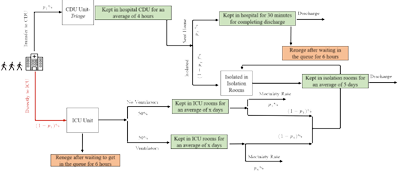

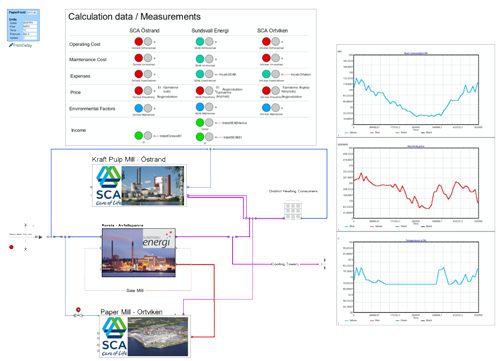





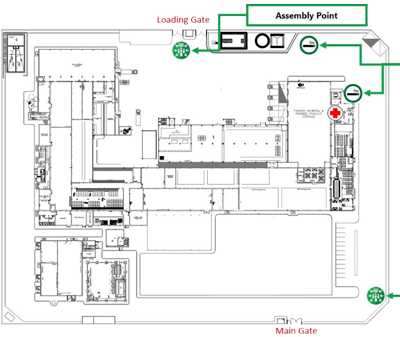
 read paper
read paper download ExtendSim model
download ExtendSim model
